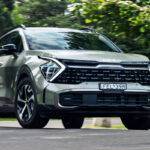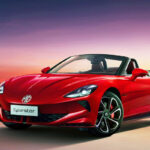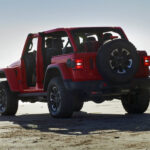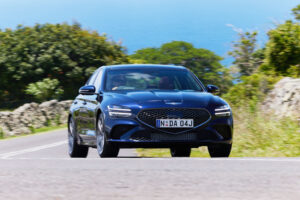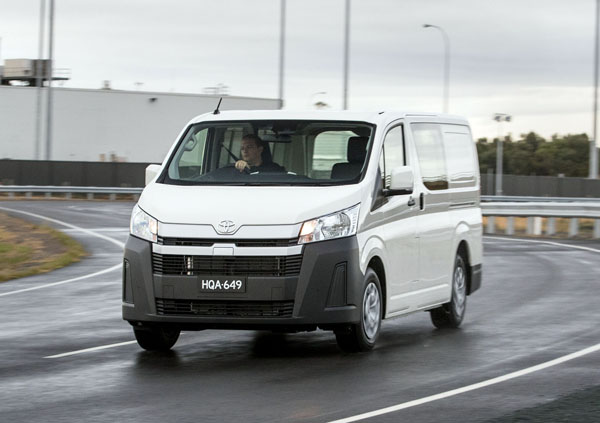
If it ain’t broke don’t fix it: this could well be the case with the HiAce, Toyota’s iconic van, which the company stuck with for 15 years without replacing. The light commercial was around until a 2019 rebirth, now it becomes the subject of a range of upgrades.
The HiAce van, and related Commuter bus and Granvia wagon, have been boosted with added technology and comfort and convenience features while offering a streamlined choice for customers.
Long the leader in the 2.5 to 3.5 tonne van segment with sales this year increasing by 51.9 per cent, customer preference for diesel power, has led to the 3.5-litre petrol V6 for HiAce being discontinued in favour of Toyota’s tough 2.8-litre turbodiesel four-cylinder engine, mated with an automatic transmission.
New safety and security technology come with the fitment of Toyota Connected Services to all models. Inside, all benefit from upgraded features, with Granvia incorporating a higher level of luxury with rear privacy glass and carpeted front floor mats now standard.
For HiAce, a large centre console box has been added to store paperwork while Commuter GL grades gain an LED lamp inside the box to aid vision, as well as upgraded USB charging ports.
The added features adopted for HiAce come with price increases of just $990 across the range, while upgraded Granvia prices rise by less than two per cent.
Both HiAce and Granvia are covered by the five-year Toyota Warranty Advantage and seven-year Toyota Warranty Advantage Extended Engine and Driveline. On test was the HiAce GL long wheelbase automatic van, selling for $47,230, plus on-road costs.
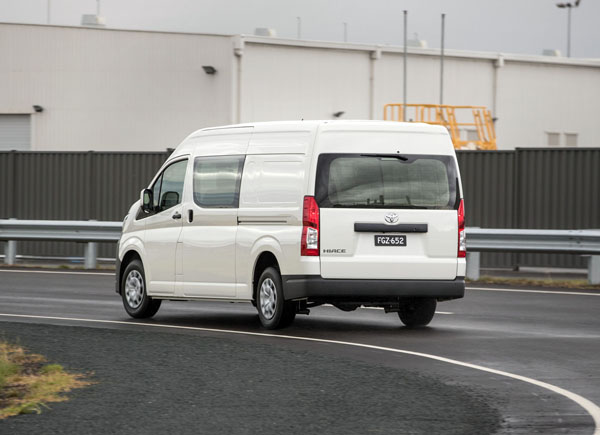
STYLING
The bonnet-forward design has enabled the engine to be ahead of the front axle and seats compared with the previous model where the engine sat under the front seats directly above the axle. It also provides easier access to the engine bay, improved safety and greater stability and ride comfort.
The wide track gives the vehicle a planted stance, while the solid sides of the front bumper have been rounded off at the grille to improve working in tight CBD spaces.
Aerodynamics are enhanced by a raked windscreen and side mouldings, chamfered rear corners and five stabilising fins on the side of the rear lamps. French Vanilla is now the only paint choice.
INTERIOR
Lack of a dedicated space for clipboard storage is a drawback, a centre console storage box as standard, replacing the existing console tray. Included in the new storage box is a removable in-box tray, an A4-sized binder rack, and a moveable partition at the rear of the box that can be used as a cupholder.
Other range-wide standard equipment additions include front all-weather floor mats, 1.5-litre bottle holder and storage bin in each front door, with cup holders in the centre and on either side of the dashboard. There’s also a glovebox and spot to the left of the gearshift for small stuff.
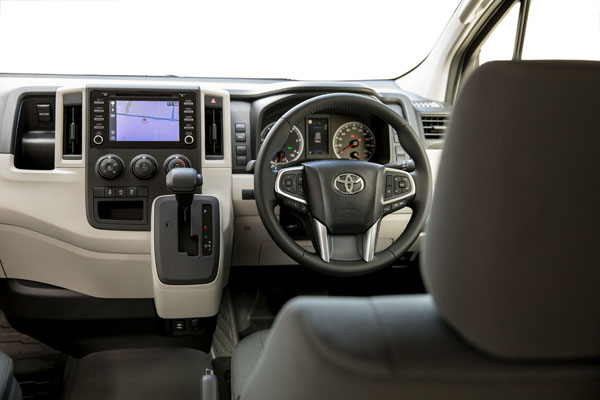
INFOTAINMENT
The multimedia system – Toyota’s latest – can be controlled via steering-wheel controls or the touchscreen that now offers pinch, swipe and flick gesture operation.
The latter also incorporates AM / FM / DAB+ radio, USB and Aux inputs, full Bluetooth connectivity, satellite navigation with SUNA live traffic alerts, voice recognition, and Toyota Link apps including weather, fuel finder and travel times. HiAces will also come standard with Apple CarPlay and Android Auto.
Other new applications include Siri eyes-free mode for iPhones and Miracast, which allows compatible smartphone screens to be duplicated onto the touchscreen. Delivering high quality audio are two front-mounted speakers.
ENGINES / TRANSMISSIONS
All versions of the HiAce and Granvia are powered by Toyota’s 2.8-litre turbo-diesel four-cylinder engine, mated to an automatic transmission, with a six-speed manual gearbox also offered on HiAce LWB van.
The turbodiesel engine develops 130 kW and 450 Nm when teamed with the six-speed automatic, however with the manual gearbox maximum torque is 420 Nm. In the HiAce Commuter, the turbodiesel engine produces maximum outputs of 120 kW of power and 420 Nm of torque.
SAFETY
The addition of Toyota Connected Services automatically generates an emergency call to Toyota’s around-the-clock emergency call centre and relay the location of the vehicle in the event of a collision that requires intervention, or if an airbag goes off.
Occupants can also manually trigger an emergency call to the call centre via an SOS button, allowing the determination of the vehicle’s location and co-ordination with emergency services.
If the vehicle is reported stolen, Toyota Connected Services can help track the vehicle’s location through the stolen vehicle tracking service.
DRIVING
The tried-and-tested diesel powerplant is muted and there’s little wind noise, leaving road rumble to intrude into the cabin. Adding loads to the cavernous cargo area puts paid to much of this unwanted driving accompaniment.
There was not much to argue with Toyota’s combined urban / highway fuel consumption figure of 8.2 litres per 100 kilometres, with the test vehicle recording 9.7 litres per 100 kilometres under city delivery duties and 6.0 litres per 100 kilometres on a highway run.
The stop / start system is one of the best encountered in any vehicle, with instantaneous fire-up from rest. For the automotive equivalent of ‘anti-vaxxers’ it can be switched off.
Driver and passenger seats are shapely, with thick cushioning for comfort and support. They are finished in quality, durable fabric. The driver’s seat offers six-way adjustment for height, slide and recline.
Payload is up to 1095 kg, while the van is rated to tow a 1500 kg braked trailer. With 1268 mm between the rear wheel arches, there’s room for two standard Aussie pallets. Total load volume is 6.2 cubic metres.
Loading through wide side doors was easy thanks to their easy slide functioning. The vertical lift tailgate – no barn doors offered – is no friend to the forklift but is a handy shelter while manual loading in wet weather.
Ride and handling on test improved with load, as you would expect from a goods hauler with rear-wheel drive. Inclines offered little limit to performance and filtering into motorway traffic presented no white-knuckle stress.
Extensive glassed areas all round and large exterior mirrors were complemented by a single window in the left side door, giving the driver confidence in overtaking, or pulling out from the kerb. A reversing camera was especially welcome in tight parking manoeuvres.
SUMMARY
While the HiAce relied for many years on its solid reputation to lead the field, Toyota has been quick to add fine touches to the latest generation of the iconic van in a bid to stave off any challenges from close rivals.
AT A GLANCE
MODEL LINE-UP
HiAce LWB van manual $44,230
HiAce LWB van automatic $46,230
HiAce LWB van 4-door auto $46,230
HiAce GL LWB van auto $47,230
HiAce Crew LWB van auto $49,230
HiAce SLWB van auto $54,230
HiAce SLWB GL van auto $55,230
HiAce SLWB Commuter bus auto $69,230
HiAce SLWB Commuter GL bus auto $72,230
Note: These prices do not include government or dealer delivery charges. Contact your local Toyota dealer for drive-away prices.
SPECIFICATIONS (Toyota HiAce GL 2.8L 4-cylinder turbodiesel, 6sp automatic, RWD van)
ENGINE:
Capacity: 2.755 litres
Configuration: Four cylinders in line
Maximum Power: 130 kW @ 3400 rpm
Maximum Torque: 450 Nm @ 1600-2400 rpm
Fuel Type: Diesel
Combined Fuel Cycle (ADR 81/02): 8.2 L/100km
CO2 emissions 219 g / km
DRIVELINE: Six-speed automatic, rear-wheel drive
DIMENSIONS, WEIGHT AND CAPACITIES:
Length: 5265mm
Wheelbase: 3210 mm
Width: 1950 mm
Height: 1990 mm
Turning Circle: 11.0 metres
Kerb Mass: 2205 kg
Fuel Tank Capacity: 70 litres
BRAKES:
Front: Ventilated disc
Rear: Disc
STANDARD WARRANTY:
Five years / unlimited kilometres




